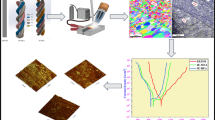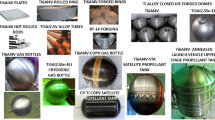Abstract
The aim of the present study was to find better developments to improve the performance of population optimization, especially from the angle of keeping the population diversity, to enhance the global search in the early part of the optimization and to encourage the particles to converge toward the global optima at the end of the search. The results were used to optimize the fabrication process conditions of the high wear resistance boron carbide-reinforced Al matrix composites. An experimental investigation was then carried out on the abrasive wear behavior of Al alloy matrix composites in terms of abrasive particle size, weight fraction and applied load in pin-on-disk type of wear machine.








Similar content being viewed by others
References
Mandala A, Murtyb BS, Chakraborty M (2009) Sliding wear behaviour of T6 treated A356–TiB2 in situ composites. Wear 266:865–872
Liu D, Zhang SQ, Li A, Wang HM (2010) Creep rupture behaviors of a laser melting deposited TiC/TA15 in situ titanium matrix composite. Mater Des 31:3127–3133
Mazahery A, Shabani MO (2012) Study on microstructure and abrasive wear behavior of sintered Al matrix composites. Ceram Int 38:4263–4269
Anandkumar R, Almeida A, Vilar R (2012) Microstructure and sliding wear resistance of an Al–12 wt% Si/TiC laser clad coating. Wear 282–283:31–39
Gopalakrishnan S, Murugan N (2011) Prediction of tensile strength of friction stir welded aluminium matrix TiCp particulate reinforced composite. Mater Des 32:462–467
Hashim J, Looney L, Hashmi MSJ (2002) Particle distribution in cast metal matrix composites. Part I. J Mater Process Technol 123:251–257
Blumenthal WR, Gray GT, Claytor TN (1994) Response of aluminium-infiltrated boron carbide cermets to shock wave loading. J Mater Sci 29:4567
Pyzik AJ, Aksay IA, Sarikaya M (1986) Processing and microstructural characterization of B4C-AI cermets. Mater Sci Res 21:45
Shabani MO, Mazahery A (2011) Prediction of mechanical properties of cast A356 alloy as a function of microstructure and cooling rate. Arch Metall Mater 56(3):671–675
Pyzik AJ, Beaman DR (1995) Al-B-C phase development and effects on mechanical properties of B4C/Al-derived composites. J Am Ceram Soc 78:305
Rhee SK (1970) Wetting of AlN and TiC by liquid Ag and liquid Cu. J Am Ceram Soc 53:386
Mazahery A, Shabani MO (2012) A356 reinforced with nano particles: numerical analysis of mechanical properties. JOM 64(2):323–329
Vugt LV, Froyen L (2000) Gravity and temperature effects on particle distribution in Al–Si/SiCp composites. J Mater Process Technol 104:133–144
Irons GA, Owusu-Boahen K (1995) Settling and clustering of silicon carbide particles in aluminium metal matrix composites. Metall Mater Trans B 26:980–981
Gowri S, Samuel FH (1992) Effect of cooling rate on the solidification behavior of Al–7 Pct Si–SiCp metal–matrix composites. Metall Trans A 23:3369–3376
Shabani MO, Mazahery A (2013) Application of GA to optimize the process conditions of Al matrix nano-composites. Compos Part B 45:185–191
Liang JJ, Qin AK, Suganthan PN, Baskar S (2006) Comprehensive learning particle swarm optimizer for global optimization of multimodal functions. IEEE Trans Evol Comput 10:281–295
Beasley D, Bull DR, Martin RR (1993) A sequential niching technique for multimodal function optimization. Evol Comput 1(2):101–125
Brits R (2002) Niching strategies for particle swarm optimization. Master’s thesis, Department of Computer Science, University of Pretoria, Pretoria, South Africa, Nov 2002
Shabani MO, Mazahery A (2012) Optimization of process conditions in casting aluminum matrix composites via interconnection of artificial neurons and progressive solutions. Ceram Int 38:4541–4547
Kennedy J (1999) Small worlds and mega-minds: effects of neighborhood topology on particle swarm performance. In: Proceedings of the IEEE congress on evolutionary computation, July 1999, pp 1931–1938
Kennedy J, Eberhart RC (1995) Particle swarm optimization. In: Proceedings of the IEEE international conference on neural networks, vol. IV. Perth, Australia, pp 1942–1948
Kennedy J, Eberhart RC (2001) Swarm intelligence. Morgan Kaufman, San Francisco
Kennedy J, Mendes R (2002) Population structure and particle swarm performance. In: Proceedings of the IEEE world congress on evolutionary computation. Honolulu, Hawaii, May 2002, pp 1671–1676
Mazahery A, Shabani MO (2012) Assistance of novel artificial intelligence in optimization of aluminum matrix nanocomposite by genetic algorithm. Metall Mater Trans A 43:5279–5285
Petalas YG, Antonopoulos CG, Bountis TC, Vrahatis MN (2009) Detecting resonances in conservative maps using evolutionary algorithms. Phys Lett A 373:334–341
Parrott D, Li X (2006) Locating and tracking multiple dynamic optima by a particle swarm model using speciation. IEEE Trans Evol Comput 10(4):440–457
Wu CH, Dong N, Ip WH, Chen CY, Yung KL, Chen ZQ (2010) Chaotic hybrid algorithm and its application in circle detection. Lect Notes Comput Sci 6024:302–311
Tripathi PK, Bandyopadhyay S, Pal SK (2007) Multi-objective particle swarm optimization with time variant inertia and acceleration coefficients. Inf Sci 177:5033–5049
Shabani MO, Mazahery A (2012) Application of finite element model and artificial neural network in characterization of Al matrix nanocomposites using various training algorithms. Metall Mater Trans A 43:2158–2165
Sathiya P, Aravindan S, Haq AN, Paneerselvam K (2009) Optimization of friction welding parameters using evolutionary computational techniques. J Mater Process Technol 209:2576–2584
Bauri R, Surappa MK (2009) Processing and compressive strength of Al–Li–SiCp composites fabricated by compound billet technique. J Mater Process Technol 209:2077–2084
Author information
Authors and Affiliations
Corresponding author
Rights and permissions
About this article
Cite this article
Rahimipour, M.R., Tofigh, A.A., Mazahery, A. et al. Strategic developments to improve the optimization performance with efficient optimum solution and produce high wear resistance aluminum–copper alloy matrix composites. Neural Comput & Applic 24, 1531–1538 (2014). https://doi.org/10.1007/s00521-013-1375-1
Received:
Accepted:
Published:
Issue Date:
DOI: https://doi.org/10.1007/s00521-013-1375-1




